A well-constructed folding bike will be able to last for over 20 years, but frequently riding your bike will start to take a toll. Mud and dirt will get into the wheels, and the impact forces of potholes can send vibrations through the frame.

Regular folding bike maintenance and repairs will keep the essential parts of your bike in optimal condition. These include; keeping the bike clean and lubricated, checking the tires, brakes, and bolts, and performing minor repairs.
In this guide, I’ll go through everything you need to know to keep your folding bike in excellent condition.
Cleaning And Lubricating a Folding Bike
As you ride your folding bike, you will get dirt, mud, and road salt caught in your bicycle. Over time, this can lead to substantial problems. The dirt can cause significant wear and tear to moving parts. Prolonged exposure to road salt might cause rusting.
Here are the steps I follow in cleaning and lubing my folding bikes:
- Wash the frame. You’ll need a bucket of warm, soapy water to do this. You can use an old rag to scrub the bike, though you will need a soft-bristled brush for stuck-on grime. You can find brushes specifically designed to go into the chain and cassette. We go into more depth about cleaning the chain in the next step. If you have disc brakes, use alcohol to clean them (not water).
- Rinse with water. Use a rag with clean water to rinse away the soap. Try to rinse the parts in the same order that you cleaned them.
- Dry the bike. Use a clean rag to rub down and dry your folding bike.
It would help if you also lubricated your folding bike regularly. Run your finger along the chain to test if this is required. It’s time to clean and lubricate the chain if it comes back looking black and greasy:
- Degrease the chain. You must spray some degreaser onto the chain and backpedal to spread it evenly over the chain. If you have disc brakes, you should cover the brake rotor before you do this. The degreaser will say how long you must keep it on the chain.
- Wipe off the degreaser. Once you’ve waited for the specified time, use an old rag to wipe off the degreaser. This should leave your chain looking clean. But if it’s still black and greasy, you can repeat this process.
- Lubricate the chain. Apply lubricant to the chain while pedaling backward to spread it evenly. Avoid getting any lubricant on your brake pads!
- Wipe away the excess lubricant. Wait for the lube to drive, then use a dry rag to remove excess.
You must also apply a small amount of lubricant to other moving parts.
Most importantly, you will need to lubricate the hinges of the folding mechanism of your folding bike. Usually, you will only need to apply a few drops of lubricant to these areas.
Once you have finished cleaning your bike, you should check the tire pressure. The ideal pressure is listed on the side of the tire. If needed, you can use a pump to boost the pressure back to optimal levels.
Common Folding Bicycle Problems and Repairs
Loose Or Rusting Bolts
You can use a drop test to check for any loose components. To do this, lift the bike a few inches off the ground, then let it fall. Listen for any loose rattles. Make sure that the fenders and chains aren’t moving too much.
If you do find a loose bolt, you will be able to tighten it yourself. You need an Allen wrench to do this.

Occasionally, a bolt might have fallen out or become too worn to tighten. Contact the manufacturer or your local bike shop and order a replacement.
You should also check for rusty bolts. The most likely places for the bolts to start rusting are; the crankshaft, pedals, brakes, and fenders. Because these folding bike components are closer to the ground, these bike parts will encounter the most moisture.
Flat Tires
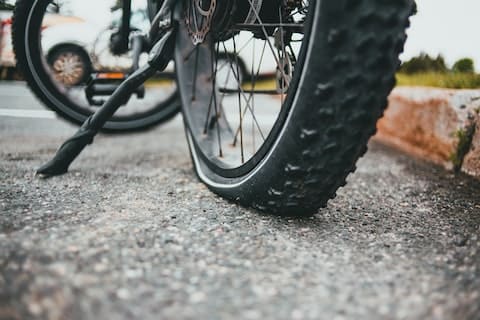
Over time, you will get punctures in the tire, causing the air to leak out. Here is how you can fix a flat tire:
- Remove the wheel. If you have rim brakes, you’ll need to slacken them first. If you need to remove the back tire, put the bike into the highest gear. Then, move to the side of the bike opposite the chain. You will then need to use the quick-release, allowing the wheel to come off. If it doesn’t come out, the chain and derailleur might be blocking it, and you’ll need to use your seat to lift your bike and move these elements out of the way.
- Remove the tire. You will need to use tire levers to do this. Place one lever under the edge of the tire and use a spoke to hold it in place. Then, you will need to place the second lever about six inches away from the first and work it around the rim to remove the tire. This will allow you to access the tube inside the tire.
- Find the cause of the problem. You can find the flat by running your fingers around the tube and feeling for any embedded objects. If not, inflate the tube and place it into a bucket of soapy water; the air bubbles will let you pinpoint the leak.
- Patch the tube, if possible. If the leak is relatively minor, you can use a repair kit to patch the damage. Place a small drop of glue over the hole and then firmly press the patch in place.
- Replace the tube. If the leak is too severe or the inner tube has been patched too often, you should consider replacing it.
- Place the tube in the tire. As you do this, inflate the inner tube a little to hold its shape and prevent pinch punctures from occurring. Then, you can align the valve stem with the tire valve hole. Carefully work the rest of the tube into the tire, checking that it isn’t getting pinched by the tire.
- Inflate the tire and re-attach it to your bike. Finally, inflate your tires to the specified PSI and return the wheel to your bike.
Rusty Or Worn-Out Chain
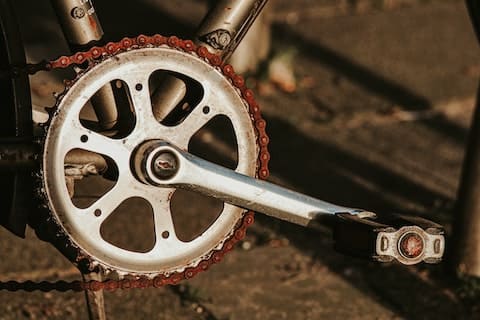
It’s vital that you closely monitor the condition of your bike chain. A rusting chain can make it harder for you to pedal. It’s relatively easy to remove the rust and get your chain looking shiny and new; here’s how:
- Remove the chain. To do this, you’ll need to find the master link and disconnect the chain. Please take a few pictures before you do this so you can reassemble it correctly.
- Apply degreaser. Depending on the condition of the chain, you may need to scrub hard to remove the grease. If the chain is severely rusted, leave it to soak in a degreaser for 20 minutes.
- Use WD-40 to remove the rust. I lightly spray WD-40 on the chain, then use a steel brush to remove the rust residue.
- Put the chain back on the bike. Place the chain back through the gear spokes and re-attach the master link. Try turning the pedals slowly; you shouldn’t feel any resistance. Then, re-lubricate the chain.
If you notice any chain warping, it’s best to replace it. Replacing the chain can be complex, so visiting your local bike shop is best.
Bent Or Damaged Rims
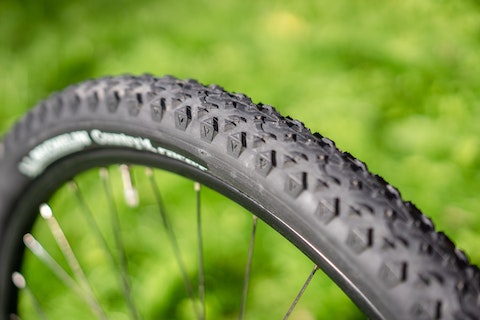
Riding a bike with a dent in the rim might feel like a minor issue. But it can cause significant problems in the future. Most commonly, the brakes will rub against the dent, increasing pressure on the tire and raising the risk of a blowout. To prevent this, here is what you should do when faced with a damaged rim:
- Inspect the rim. Start by turning your folding bicycle upside down and slowly turning the rim. Observe its distance from the brake pad. Ideally, it should always remain the same distance from the brake pad. If not, you can identify the buckled areas.
- Tighten the spoke opposite the bend. Insert the wrench into the nipple of the spoke and turn it clockwise. Depending on the buckle’s size, you might need to tighten a few spokes to straighten it out. For larger dents, loosen the spoke opposite to the one you are tensioning.
- Check the rim. Before you do this, squeeze each pair of spokes to release the pressure. Then, slowly turn the wheel to ensure the rim has been straightened.
This method will work on minor dents. If your rim is severely bent, you must take it to your local bike store, where they will use specialized equipment to fix it.
Folding Bike Seatpost Slipping Down
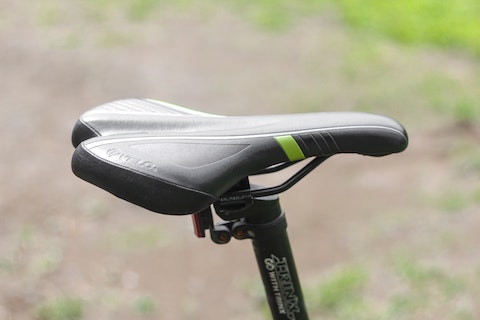
Often, you will need to slide the seatpost of your folding bike up or down to activate the folding mechanism. Over time, though, this can loosen the quick-release system in the seatpost. As a result, it can start to slide down when you are riding. Here’s how I prevent the seatpost from slipping down:
- Remove the quick-release
- Use a rag to clean the area
- Apply lubrication around the quick release. Wait for the lube to dry before using a rag to remove the excess.
- Use a degreaser to clean the seat post
- Re-install the quick-release. Make sure to avoid over-tightening, as the excess pressure can start to damage the frame.
Routine Folding Bike Maintenance Tasks
So far, we’ve looked at some maintenance tasks that should be done sporadically. Now let’s focus on things you will need to do more frequently. If you are commuting to work regularly, you should try to perform the following tasks once a week:
1. Checking the bolts and tightening them if necessary. You can drop the bike from a few inches. This allows you to listen for the rattle of loose bolts. You’ll usually need a set of screwdrivers or wrenches to tighten a loose screw.
2. Checking the tires and inflating them. All tubes will slowly leak air, so you must regularly check the tire pressure. The ideal pressure is listed on the side of the tire. If it’s too low, inflate the tires to raise the pressure.
3. Lubricating the chain and other moving parts. Without adequate lubrication, these elements will grow stiff. In particular, you’ll need to lubricate; the chain, the folding mechanism, derailleur assemblies, brake cables, shifter cables, and the pedal spindle.
4. Checking the brakes and adjusting or replacing the pads if necessary. To check the brakes, you need to squeeze the lever. It should feel firm and responsive. If it’s spongy, you might need to adjust the amount of tension on the brake cable. If that doesn’t solve the problem, or you notice a squeaking sound when braking, you might need to replace your brake pads.
To replace the brake pads, you will need to:
- Use a flat-head screwdriver to push the pads into the caliper
- Take off the pad retainer
- Remove the old pads
- Clean the caliper with a soft-bristled brush
- Put the pad retainer back on
- Put the brake pads back on the bike and slowly turn the wheel to ensure the tire isn’t hitting the pads.
After you’ve replaced the brakes, you’ll need to break them in. To do this, pedal hard to accelerate your bike, then hit the brakes. Repeat this process a few times so the brakes respond promptly when you squeeze the lever.
5. Check headset bearings and assembly. Pay attention to the way your bike steers. If it’s a little looser than usual, it might be a problem with the headset bearings. You can easily confirm this by gently rocking the bike back and forward. You shouldn’t be able to hear any clunking or feel the steering bars shaking.
Thankfully, tightening the steering column bearings is easy. Loosen the pinch bolts so the steering goes slack. Then, you can use a wrench to tighten the steering bearings. Beware of over-tightening; add enough tension to stop the steering assembly from shaking.
6. Inspect the frame and forks for cracks or damage. Lastly, spend a few minutes checking over the frame. Look for any dents or signs of warping. Check for cracks; these are most common around the hinge points, as these parts of the structure are put under the most strain.
Tips for Repairing Your Folding Bike
Here are some suggestions to make maintaining and repairing your folding bike easier:
- Get familiar with the bike and its components. Spend some time riding your bike, so you know how it should handle. This makes it easier to detect and accurately diagnose problems.
- Keep a tool kit on hand. You don’t need a lot of tools. Most of the time, you should require; screwdrivers, winches, a pump, tire levers, and spare parts, like inner tubes.
- Learn basic bike repair techniques. You should learn to perform basic repairs, like changing a flat tire or replacing a brake pad. Many online resources, like YouTube videos, walk you through the process.
- Know when to take the bike to a professional. Of course, you can’t do everything yourself. If you lack experience or the bike repair tools to fix a problem, visiting your local bike shop is best.
Folding Bike Maintenance Verdict
Caring for a folding bike doesn’t have to be a complex task. You’ll have to clean it and inflate the tires most of the time. Based on what you learned in this folding bike maintenance guide, you should now also be capable to perform minor repairs, like patching a flat tire or repairing a dented rim.
Learning to do this yourself will be worth the effort as you’ll be able to save on bike shop fees. Even better, a well-maintained folding bike can last for 20 years.

![How Much Do Folding Bikes Cost in [year]: Are They Worth It?](https://www.foldingbikeguy.com/wp-content/uploads/How-Much-Do-Folding-Bikes-Cost.jpg)
![How Much Do Folding Bikes Weigh in [year]? Weight Limits Revealed](https://www.foldingbikeguy.com/wp-content/uploads/How-Much-Do-Folding-Bikes-Weigh.jpg)
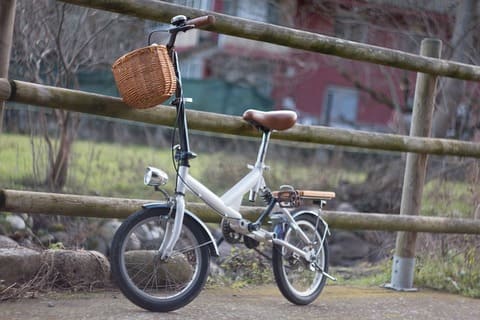
![Best Lightweight Folding Bike [Year] (8 Lightest Foldables)](https://www.foldingbikeguy.com/wp-content/uploads/Best-Lightweight-Folding-Bike.jpg)

![What is the Smallest Folding Bike? 6 Most Compact Bikes [Year]](https://www.foldingbikeguy.com/wp-content/uploads/What-is-the-Smallest-Folding-Bike.jpg)